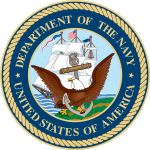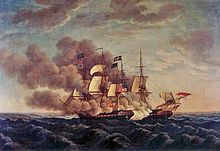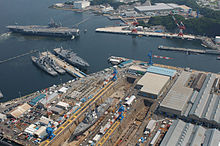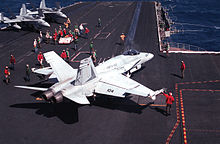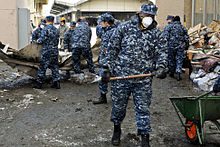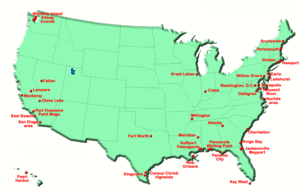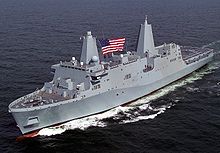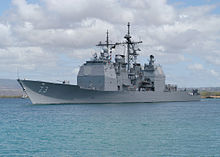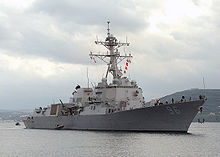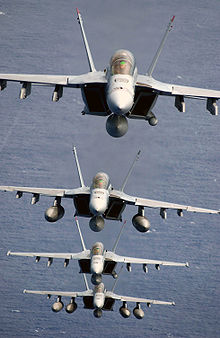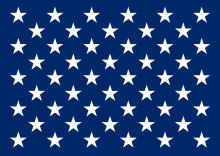- United States Navy
-
The United States Navy (USN) is the naval warfare service branch of the United States Armed Forces and one of the seven uniformed services of the United States. The U.S. Navy is the largest in the world; its battle fleet tonnage is greater than that of the next 13 largest navies combined.[4] The U.S. Navy also has the world's largest carrier fleet, with 11 in service, one under construction (two planned), and one in reserve. The service had 328,516 personnel on active duty and 101,689 in the Navy Reserve in January 2011. It operates 286 ships in active service and more than 3,700 aircraft.[2]
The Navy traces its origins to the Continental Navy, which was established during the American Revolutionary War and was essentially disbanded as a separate entity shortly thereafter. The United States Constitution provided the legal basis for a military force by giving Congress the power "to provide and maintain a navy".[5]
Depredations against U.S. shipping by Barbary Coast pirates in the Mediterranean Sea spurred Congress to employ this power by passing the Naval Act of 1794 ordering the construction and manning of six frigates.[6] These ships were used to end most pirate activity off the Barbary Coast. In the 20th century American blue-water navy capability was demonstrated by the 1907–1909 world tour of the Great White Fleet.
The 21st century United States Navy maintains a sizable global presence, deploying in such areas as East Asia, the Mediterranean, and the Middle East. It is a blue-water navy with the ability to project force onto the littoral regions of the world, engage in forward areas during peacetime, and rapidly respond to regional crises, making it an active player in U.S. foreign and defense policy.
The Navy is administratively managed by the Department of the Navy, which is headed by the civilian Secretary of the Navy. The Department of the Navy is itself a division of the Department of Defense, which is headed by the Secretary of Defense. Traditionally, the highest ranking naval officer is the Chief of Naval Operations, a position currently held by Admiral Jonathan Greenert, however one naval officer currently outranks him. The highest ranking naval officer is the Vice Chairman of the Joint Chiefs of Staff, Admiral James Winnefeld.
Contents
Mission
The mission of the Navy is to maintain, train and equip combat-ready Naval forces capable of winning wars, deterring aggression and maintaining freedom of the seas.From the New Recruits Handbook:
The mission of the United States Navy is to protect and defend the right of the United States and our allies to move freely on the oceans and to protect our country against her enemies.The United States Navy serves as a seaborne branch of the Military of the United States. 10 U.S.C. § 5062 prescribes the Navy's three primary areas of responsibility:
- "The preparation of naval forces necessary for the effective prosecution of war"
- "The maintenance of naval aviation, including land-based naval aviation, air transport essential for naval operations and all air weapons and air techniques involved in the operations and activities of the Navy"
- "The development of aircraft, weapons, tactics, technique, organization, and equipment of naval combat and service elements".
U.S. Navy training manuals state the mission of the U.S armed forces is "to prepare and conduct prompt and sustained combat operations in support of the national interest". As part of that establishment, the U.S. Navy's functions comprise sea control, power projection and nuclear deterrence, in addition to "sealift" duties.[8]
History
Origins
Without a decisive naval force we can do nothing definitive.In the early stages of the American Revolutionary War, the establishment of an official navy was an issue of debate among the members of the Continental Congress. Supporters argued that a navy would protect shipping, defend the coast, and make it easier to seek out support from foreign countries. Detractors countered that challenging the British Royal Navy, then the world's preeminent naval power, was a foolish undertaking.[6]
Commander in Chief George Washington commissioned seven ocean-going cruisers to interdict British supply ships, and reported the captures to the Congress. This effectively ended the debate in Congress as to whether or not to "provoke" the British by establishing a Navy as Washington's ships had already captured British ships, somewhat a provocation.
While Congress deliberated, it received word that two unarmed British supply ships from England were heading towards Quebec without escort. A plan was drawn up to intercept the ships—however, the armed vessels to be used were owned not by Congress, but by individual colonies. Of greater significance then was an additional plan to equip two ships that would operate under the direct authority of Congress to capture British supply ships. This was not carried out until 13 October 1775, when George Washington announced that he had taken command of three armed schooners under Continental authority to intercept any British supply ships near Massachusetts. With the revelation that vessels were already sailing under Continental control, the decision to add two more was made easier;[10] the resolution was adopted and 13 October would later become known as the U.S. Navy's official birthday.[11]
The Continental Navy achieved mixed results; it was successful in a number of engagements and raided many British merchant vessels, but it lost 24 of its vessels[12] and at one point was reduced to two in active service.[13] As Congress turned its attention after the conflict towards securing the western border of the new United States, a standing navy was considered to be dispensable because of its high operating costs and its limited number of roles.[6]
From reestablishment to the Civil War
We ought to begin a naval power, if we mean to carry on our commerce.The United States would be without a navy for nearly a decade—a state of affairs that exposed its merchant ships to a series of attacks by Barbary pirates. The sole armed maritime presence between 1790 and the launching of the U.S. Navy's first warships in 1797 was the U.S. Revenue Cutter Service (USRCS), the primary predecessor of the U.S. Coast Guard. Although USRCS Cutters conducted operations against these pirates, the depredations far outstripped the abilities of the USRCS and Congress ordered the construction and manning of six frigates on 27 March 1794;[12] three years later the first three were welcomed into service: the USS United States, USS Constellation and USS Constitution.
Following an undeclared Quasi-War with France, the U.S. Navy saw substantial action in the War of 1812, where it was victorious in numerous single-ship duels with the Royal Navy. The Navy drove all significant British forces off of Lake Erie and Lake Champlain and prevented them from becoming British controlled zones of conflict. Despite this, the U.S. Navy was unable to prevent the British from blockading American ports and landing troops on American soil.[6] After the war, the U.S. Navy again focused its attention on protecting American shipping assets, sending squadrons to the Caribbean, the Mediterranean, South America, Africa, and the Pacific.[12]
During the Mexican-American War the U.S. Navy contributed by instituting blockades of Mexican ports, capturing or burning the Mexican fleet in the Gulf of California and capturing all major cities in Baja California peninsula—later returned. In 1846-1848 the navy successfully used the Pacific Squadron under Commodore (Rear Admiral) Robert Stockton and its marines and blue-jackets to facilitate the capture of California with large scale land operations coordinated with the local militia organized in the California Battalion. The navy conducted the U.S. military's first large-scale amphibious joint operation by successfully landing 12,000 army troops with their equipment in one day at Veracruz, Mexico. When larger guns were needed to bombard Veracruz Navy volunteers landed large navy guns and manned them in the successful bombardment of the city and its surrender. This successful landing and capture of Veracruz eventually opening the way for the capture of Mexico City and the end of the war.[6] The United States Navy established itself as a player in American foreign policy through the actions of Commodore Matthew Perry in Japan, which resulted in the Convention of Kanagawa in 1854.
Naval power would play a significant role during the American Civil War, where the Union had a distinct advantage over the Confederacy on the seas.[6] A Union blockade on shipping handicapped the Southern effort throughout the conflict. The two American navies would help usher in a new era in world naval history by putting ironclad warships into combat for the first time. The Battle of Hampton Roads in 1862, which pitted USS Monitor against CSS Virginia, became the first engagement between two steam-powered ironclads.[13] Soon after the war, however, the U.S. Navy's fleet slipped into obsolescence because of neglect.
20th century
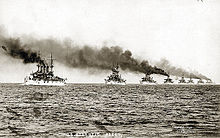 The Great White Fleet demonstrates U.S. naval power in 1907; it was proof that the US Navy had blue-water capability.
The Great White Fleet demonstrates U.S. naval power in 1907; it was proof that the US Navy had blue-water capability. Our ships are our natural bulwarks.
Our ships are our natural bulwarks.A modernization program beginning in the 1880s brought the U.S. in line with the navies of countries such as Britain and Germany. In 1907, most of the Navy's battleships, with several support vessels, dubbed the Great White Fleet, were showcased in a 14-month circumnavigation of the world. Ordered by President Theodore Roosevelt, it was a mission designed to demonstrate the Navy's capability to extend to the global theater.[12]
The Navy saw little action during World War I, but nevertheless the strength of the United States Navy grew under an ambitious ship building program associated with the Naval Act of 1916. Naval construction, especially of battleships was later limited by the Washington Naval Conference of 1921-22, however, construction of aircraft carriers continued, accelerating after the New Deal. which provided funding for the construction of the USS Yorktown (CV-5) and USS Enterprise (CV-6). These ships would not have been built had it not been for the demonstrations of the capability of aircraft against ships by Gen Billy Mitchel. By 1936, with the completion of the USS Wasp (CV-7), the U.S. Navy possessed a carrier fleet of 165,000 tonnes displacement, although this figure was nominally recorded as 135,000 tonnes to comply with treaty limitations.
World War II
The U.S. Navy grew into a formidable force in the years prior to World War II, with battleship production being restarted in 1937, commencing with the USS North Carolina (BB-55). Though ultimately unsuccessful, Japan attempted to allay this strategic threat with the 1941 surprise attack on Pearl Harbor. Following American entry into the war, the U.S. Navy grew tremendously as the United States was faced with a two-front war on the seas. It achieved notable acclaim in the Pacific Theater, where it was instrumental to the Allies' successful "island hopping" campaign.[13] The U.S. Navy participated in many significant battles, including the Battle of the Coral Sea, the Battle of Midway, the Battle of the Philippine Sea, the Battle of Leyte Gulf, and the Battle of Okinawa. By 1943, the Navy's size was larger than the combined fleets of all the other combatant nations in World War II.[15] By war's end in 1945, the United States Navy had added hundreds of new ships, including 18 aircraft carriers and 8 battleships, and had over 70% of the world's total numbers and total tonnage of naval vessels of 1,000 tons or greater.[16][17] At its peak, the U.S. Navy was operating 6,768 ships on V-J Day in August 1945.[18]
Doctrine had significantly shifted by the end of the war. The United States Navy had followed in the footsteps of the navies of Great Britain and Germany which favored concentrated groups of battleships as their main offensive naval weapons.[19] The development of the aircraft carrier and its devastating utilization by the Japanese against the U.S. at Pearl Harbor however shifted U.S. thinking. The Pearl Harbor attack destroyed or took out of action a significant number of U.S.N. battleships. This placed much of the burden of retaliating against the Japanese on the small number of aircraft carriers.[20]
The potential for armed conflict with the Soviet Union during the Cold War pushed the U.S. Navy to continue its technological advancement by developing new weapons systems, ships, and aircraft. United States naval strategy changed to that of forward deployment in support of U.S. allies with an emphasis on carrier battle groups.[21]
The Navy was a major participant in the Vietnam War, blockaded Cuba during the Cuban Missile Crisis, and, through the use of ballistic missile submarines, became an important aspect of the United States' nuclear strategic deterrence policy. The United States Navy conducted various combat operations in the Persian Gulf against Iran in 1987 and 1988, most notably Operation Praying Mantis. The Navy was extensively involved in Operation Urgent Fury, Operation Desert Shield, Operation Desert Storm, Operation Deliberate Force, Operation Allied Force, Operation Desert Fox and Operation Southern Watch.
The U.S. Navy has also been involved in Search and Rescue/Search and Salvage operations, some times in conjunction with vessels of other countries as well as with U.S. Coast Guard ships. Two examples are the 1966 Palomares B-52 crash incident and search for the nuclear bombs, and the Task Force 71 of the Seventh Fleet operation in search for Korean Air Lines Flight 007 shot down by the Soviets on Sept. 1, 1983.
21st century
When a crisis confronts the nation, the first question often asked by policymakers is: 'What naval forces are available and how fast can they be on station?'The United States Navy continues to be a major support to U.S. interests in the 21st century. Since the end of the Cold War, it has shifted its focus from preparations for large-scale war with the Soviet Union to special operations and strike missions in regional conflicts.[23] The Navy participated in Operation Enduring Freedom, Operation Iraqi Freedom, and is a major participant in the ongoing War on Terror, largely in this capacity. Development continues on new ships and weapons, including the Gerald R. Ford class aircraft carrier and the Littoral combat ship. Because of its size, weapons technology, and ability to project force far from U.S. shores, the current U.S. Navy remains a potent asset for the United States Commander-in-Chief (the President of the United States).
In 2007, the U.S. Navy joined with the U.S. Marine Corps and U.S. Coast Guard to adopt a new maritime strategy called A Cooperative Strategy for 21st Century Seapower that raises the notion of prevention of war to the same philosophical level as the conduct of war. The strategy was presented by the Chief of Naval Operations, the Commandant of the Marine Corps and Commandant of the Coast Guard at the International Sea power Symposium in Newport, R.I. on 17 October 2007.[24] The strategy recognized the economic links of the global system and how any disruption due to regional crises—man made or natural—can adversely impact the U.S. economy and quality of life. This new strategy charts a course for the Navy, Coast Guard and Marine Corps to work collectively with each other and international partners to prevent these crises from occurring or reacting quickly should one occur to prevent negative impacts on the United States.
In 2010, Chief of Naval Operations, Admiral Gary Roughead noted that demands on the Navy have grown as the fleet has shrunk and that in the face of declining budgets in the future, the US Navy must rely even more on international partnerships.[25]
Organization
Main article: Structure of the United States NavyThe Navy falls under the administration of the Department of the Navy, under civilian leadership of the Secretary of the Navy (SECNAV). The most senior naval officer is the Chief of Naval Operations (CNO), a four-star admiral who is immediately under and reports to the Secretary of the Navy. At the same time, the Chief of Naval Operations is one of the Joint Chiefs of Staff, which is the second-highest deliberatory body of the armed forces after the United States National Security Council, although it only plays an advisory role to the President and does not nominally form part of the chain of command. The Secretary of the Navy and Chief of Naval Operations are responsible for organizing, recruiting, training, and equipping the Navy so that it is ready for operation under the command of the Unified Combatant Commanders.
Operating forces
There are nine components in the operating forces of the U.S. Navy: the United States Fleet Forces Command, United States Pacific Fleet, United States Naval Forces Central Command, United States Naval Forces Europe, Naval Network Warfare Command, Navy Reserve, United States Naval Special Warfare Command, Operational Test and Evaluation Force, and Military Sealift Command. Fleet Forces Command controls a number of unique capabilities, including Military Sealift Command, Naval Expeditionary Combat Command, and Navy Cyber Forces.
The United States Navy has six active numbered fleets — Third, Fifth, Sixth, Seventh Fleet and Tenth Fleets are each led by a three-star vice admiral, and the Fourth Fleet is led by a rear admiral. These six fleets are further grouped under Fleet Forces Command (the former Atlantic Fleet), Pacific Fleet, Naval Forces Europe-Africa, and Naval Forces Central Command, whose commander also doubles as Commander Fifth Fleet; the first three commands being led by four-star full admirals. The United States First Fleet existed after the Second World War from 1947, but it was redesignated Third Fleet in early 1973. In early 2008, the Navy reactivated the United States Fourth Fleet to control operations in the area controlled by Southern Command, which consists of US assets in and around Central and South America.[26]
Shore establishments
Shore establishments exist to support the mission of the fleet through the use of facilities on land. Among the commands of the shore establishment, as of April 2011, are the Naval Education and Training Command, the Naval Meteorology and Oceanography Command, the Space and Naval Warfare Systems Command, the Naval Facilities Engineering Command, the Naval Supply Systems Command, the Naval Air Systems Command, the Naval Sea Systems Command, the Bureau of Medicine and Surgery, the Bureau of Naval Personnel, the United States Naval Academy, the Naval Safety Center, the Naval Strike and Air Warfare Center, and the United States Naval Observatory.[27] Official Navy websites list the Office of the Chief of Naval Operations and the Chief of Naval Operations (CNO) as part of the shore establishment, but these two entities effectively sit superior to the other organizations, playing a coordinating role.
Relationships with other service branches
United States Marine Corps
In 1834, the Marines came under the Department of the Navy.[28] Historically, the United States Navy has had a unique relationship with the United States Marine Corps (USMC), partly because they both specialize in seaborne operations. Together the Navy and Marine Corps form the Department of the Navy and report to the Secretary of the Navy. However, the USMC is considered to be a distinct, separate service branch with its own uniformed service chief - the Commandant of the Marine Corps (CMC), a four star general.
The Navy and Marine Corps have a distinct relationship, the USMC depends on the Navy for religious support (i.e. chaplains) and medical support (i.e., dentists, medical doctors, medics known as "Corpsmen" and medical service staff); thus officers and enlisted sailors from the Navy fulfill these roles. When attached to Marine Corps units deployed to an operational environment they generally wear Marine camouflage uniforms, but otherwise they wear Navy dress uniforms unless they opt to conform to USMC grooming standards (appearance).
In the operational environment, as an expeditionary force specializing in amphibious operations, Marines often embark on Navy ships in order to conduct operations from beyond territorial waters. Marine units deploying as part of a Marine Air-Ground Task Force (MAGTF) operate under the command of the existing Marine chain of command. Although Marine units routinely operate from amphibious assault ships the relationship has evolved over the years much as the "CAG" (Commander of the Carrier Air Group/Wing) does not work for the carrier Commanding Officer (CO), but coordinates with the ship's CO and staff. Some Marine aviation squadrons, usually fixed-wing assigned to Carrier Air Wings (CVW) train and operate alongside Navy squadrons, flying similar missions and often flying sorties together under the cognizance of the "CAG". Aviation is where the Navy and Marine share the most common ground, since aircrews are guided in their use of aircraft by standard procedures outlined in series of publications known as NATOPS manuals.
United States Coast Guard
Although the Posse Comitatus Act, which prevents federal military personnel from acting in a law enforcement capacity, applies only to the Army and Air Force, Department of Defense rules effectively require the Navy and Marine Corps to act as if Posse Comitatus did apply, preventing them from enforcing Federal law. The United States Coast Guard fulfills this law enforcement role in naval operations. It provides Law Enforcement Detachments (LEDETs) to Navy vessels, where they perform arrests and other law enforcement duties during Navy boarding and interdiction missions. In times of war, or when directed by the President, the Coast Guard operates as a service in the Navy and is subject to the orders of the Secretary of the Navy until it is transferred back to the Department of Homeland Security.[29] At other times, Coast Guard Port Security Units are sent overseas to guard the security of ports and other assets. The Coast Guard also jointly staffs the Navy's Naval Coastal Warfare Groups and Squadrons (the latter of which were known as Harbor Defense Commands until late-2004), which oversee defense efforts in foreign littoral combat and inshore areas. Additionally, Coast Guard and Navy vessels sometimes operate together in search and rescue operations.
Personnel
 A "shooter" in working uniform gives the signal to launch an F/A-18 Super Hornet from the USS Enterprise (CVN-65).
A "shooter" in working uniform gives the signal to launch an F/A-18 Super Hornet from the USS Enterprise (CVN-65).
The United States Navy has nearly 500,000 personnel, approximately a quarter of whom are in ready reserve. Of those on active duty, more than eighty percent are enlisted sailors, and around fifteen percent are commissioned officers; the rest are midshipmen of the United States Naval Academy and midshipmen of the Naval Reserve Officer Training Corps at over 180 universities around the country and officer candidates at the Navy's Officer Candidate School.[2]
Sailors prove they have mastered skills and deserve responsibilities by completing Personnel Qualification Standards (PQS) tasks and examinations. Among the most important is the "warfare qualification", which denotes a journeyman level of capability in Surface Warfare, Aviation Warfare, Naval Aircrew, Special Warfare, Submarine Warfare or Expeditionary Warfare. Many qualifications are denoted on a sailor's uniform with U.S. Navy badges and insignia.
Commissioned officer
Commissioned officers in the Navy have pay grades ranging from O-1 to O-10, with O-10 being the highest; those with paygrades between O-1 through O-4 are considered junior officers and O-5 and O-6 as senior officers. Officers in the O-7 to O-10 range are called flag officers or "the admiralty". Promotion through O-8 is based on performance in an officer's current paygrade, which is recorded in "FITREPS" (fitness reports). Promotions to Vice Admiral (O-9) and Admiral (O-10) are based on assignment to specific positions and subject to U.S. Senate confirmation. Above the rank of Admiral is Fleet Admiral, which was awarded to only four officers in World War II and is intended to be used only during a declared war. In 1899, a special rank called Admiral of the Navy was created for Admiral George Dewey, a war hero of the Spanish-American War, with the condition that it would cease to exist upon his death.[30][31] Commissioned officers originate from the United States Naval Academy, Naval Reserve Officer Training Corps (NROTC), Officer Candidate School (OCS), and a host of other commissioning programs such as the Seaman to Admiral-21 program, the Limited Duty Officer and Chief Warrant Officer Selection Programs, the United States Merchant Marine Academy, or receive direct commissions via Officer Development School (ODS) or from its reserve component, the Direct Commission Officer School (DCO School).
Commissioned officers can generally be divided into line officers and staff corps; line officers can be further split into unrestricted and restricted communities. Unrestricted Line Officers are the warfighting command element and are authorized to command ships, aviation squadrons, and special operations units. Restricted Line Officers, on the other hand, concentrate on non-combat related fields, such as engineering and maintenance; they are not qualified to command combat units. Staff Corps officers are specialists in fields that are themselves professional careers and not exclusive to the military, for example: medicine, science, law, and civil engineering.
Commissioned Officer Rank Structure of the United States Navy Fleet Admiral Admiral Vice Admiral Rear Admiral[32][33] Rear Admiral
(lower half)Special O-10 O-9 O-8 O-7 




FADM ADM VADM RADM RDML Captain Commander Lieutenant Commander Lieutenant Lieutenant
(junior grade)[32][33]Ensign O-6 O-5 O-4 O-3 O-2 O-1 





CAPT CDR LCDR LT LTJG ENS Chief Warrant Officer
Chief Warrant Officer (CWO) pay grades range from W-2 to the highest rank of W-5. United States Navy CWOs are officers whose role is to provide leadership and skills for the most difficult and demanding operations in a particular technical specialty. They occupy a niche that is not as well served by the line officer community, who tend to have a broader focus. CWOs come from the senior non-commissioned officer ranks of the enlisted and receive their commission after completing the Chief Warrant Officer Program. They typically become CWOs in specialties that are most related to their previous enlisted rating. Like Staff Corps officers, CWOs wear special insignia above the rank devices on their shoulder boards and sleeves to indicate their field of expertise.
Commissioned Warrant Officer Rank Structure of the United States Navy Chief Warrant Officer Five Chief Warrant Officer Four Chief Warrant Officer Three Chief Warrant Officer Two W-5 W-4 W-3 W-2 



Enlisted sailors
 Petty Officers wearing service dress uniforms pose for a photograph in front of the Netherlands Carillon at Arlington National Cemetery.
Petty Officers wearing service dress uniforms pose for a photograph in front of the Netherlands Carillon at Arlington National Cemetery.
Enlisted members of the Navy have pay grades from E-1 to E-9, with E-9 being the highest. All enlisted sailors with paygrades of E-4 and higher are considered Petty Officers while those at E-7 and higher are further named Chief Petty Officers. Those who demonstrate superior performance are given an increase in paygrade; the official Navy term is to be advanced. Two notable advancements are from Seaman to Petty Officer Third Class (E-3 to E-4) and from Petty Officer First Class to Chief Petty Officer (E-6 to E-7). Advancement to Chief Petty Officer is especially significant and is marked by a special induction ceremony.
Enlisted members are said to be "rated", meaning that they possess a rating, or occupational specialty. Members of grades E-1 to E-3 can become "strikers", meaning they have rating designations like Petty Officer (example: a BM3 is a Petty Officer Third Class rated as a Boatswain's Mate; BMSN is a Seaman designated as a Boatswain's Mate striker), but the striker is doing on the job training to become a rated petty officer rather than attending a school to become rated. There are more than 50 ratings covering a broad range of skills and subspecialties. However most sailors in today's navy with grades E-1 through E-6 obtain their rating through its respective "A" school. An "A" school is a rating specific school where sailors are trained as experts in their field. Upon completion of their training they are considered "Rated", regardless of their pay-grade.
For example, SA SMITH, MARY, would be considered a Seaman Apprentice. Prior to her rank of SA a rating would be placed. Therefore, her entire title would be ITSA SMITH, MARY. IT indicating that she is an Information Systems Technician. As for ENFN THOMPSON, JOHN. EN specifying that he is an Engineman and FN as Fireman.
Non-Commissioned Officer and Enlisted Rate Structure of the United States Navy Master Chief Petty Officer of the Navy Fleet/Force Master Chief Petty Officer Command Master Chief Petty Officer Master Chief Petty Officer Senior Chief Petty Officer Chief Petty Officer E-9 E-8 E-7 











Petty Officer First Class Petty Officer Second Class Petty Officer Third Class Seaman Seaman Apprentice Seaman Recruit E-6 E-5 E-4 E-3 E-2 E-1 




No insignia Uniforms and appearance
The uniforms of the United States Navy are designed "to combine professionalism and naval heritage with versatility, safety, and comfort".[34] The Navy currently incorporates many different styles that are specific for a variety of uses and occasions. In most cases, distinctions are made to distinguish officers and enlisted men in their uniformed appearance. U.S. Navy uniforms can generally be divided into three categories: dress uniforms, service uniforms, and working uniforms.
- Dress uniforms are worn during military-related formal occasions, such as ceremonies and other official functions. Many types of dress uniforms are used in the Navy with the full range of formal requirements represented. Service dress is the least formal dress uniform, full dress is one step higher in formality, and mess dress is the most formal dress available.
- Service uniforms are designed for daily wear and are most often worn in office or classroom-type settings, as well as other occasions in which physical activity is at a minimum.[35] The most visible distinction between officers and enlisted personnel are the color of the service uniform. Only officers and chief petty officers are authorized to wear Service Khaki or Service White; all other personnel must wear the Navy Service Uniform (which will eventually replace Winter Blue and Summer White).[36]
- Working uniforms prioritize comfort and safety first and thus are the most utilitarian of the Navy uniforms. They are intended for use in underway ships and in occasions that involve dirty, physical labor. Many working uniforms are variations of the service uniforms except with less formal requirements. This category includes Navy coveralls, which are authorized to be worn by members of all ranks.
Recently, the Navy completed a project named "Task Force Uniform" to streamline Navy uniforms. Among the changes are that enlisted personnel from Seaman Recruit to Petty Officer First Class (E1–E6) will have one year-round service uniform instead of winter blues and summer whites. All personnel from Seaman Recruit to Admiral will also have new working uniforms dubbed Navy Working Uniform (NWU) to replace the wash khakis, coveralls, utilities, and aviation working greens currently in use. The uniform is a digital patterned camouflage in predominantly haze gray and blue hues.[37]
Grooming for both male and female sailors is regulated to a high degree, with exact standards in regards to hair, facial hair, use of cosmetics, and jewelry. New male recruits are given the military crew cut and are prohibited from having hair longer than four inches (102 mm) while in the service. Men are required to be clean shaven at all times, although mustaches are allowed. Women do not have a hair length regulation, however hair cannot fall past the bottom edge of the uniform collar and the style of hair is strictly controlled. Multicolored hair, body piercing, and tattoos on the head, neck, and hands are banned for both sexes.[38]
Bases
The size, complexity, and international presence of the United States Navy require a large number of navy installations to support its operations. While the majority of bases are located inside the United States itself, the Navy maintains a significant number of facilities abroad, either in U.S.-controlled territories or in foreign countries under a Status of Forces Agreement (SOFA).
Eastern United States
The second largest concentration of installations is in Hampton Roads, Virginia, where the Navy occupies over 36,000 acres (146 km²) of land. Located in Hampton Roads are NS Norfolk, homeport of the Atlantic Fleet, NAS Oceana, a Master Jet Base, Naval Amphibious Base Little Creek, as well as a number of Navy and commercial shipyards that service Navy vessels. The state of Florida is the location of three major bases, Naval Station Mayport, the Navy's fourth largest, in Jacksonville, Florida, Naval Air Station Jacksonville, a Master Air Anti-submarine Warfare base, and Naval Air Station Pensacola, home of the Naval Education and Training Command, the Naval Air Technical Training Center that provides specialty training for enlisted aviation personnel, and the primary flight training base for Navy and Marine Corps Naval Flight Officers and enlisted Naval Aircrewmen. There is also Naval Support Activity in Panama City Beach, Florida which is home to the Navy Diving and Salvage Training Center. The main U.S. Navy submarine bases on the east coast are located in Groton, Connecticut and Kings Bay, Georgia. There are also naval bases in Portsmouth, New Hampshire and Brunswick, Maine.[39] Naval Station Great Lakes, north of Chicago, Illinois is the home of the navy's boot camp for enlisted sailors.
Western United States and Hawaii
The Navy's largest complex is China Lake, California, which covers 1.1 million acres (4,500 km²) of land, or approximately 1/3 of the United States Navy's total land holdings.[39]
Naval Base San Diego, California is principal home to the Pacific Fleet (although the headquarters is located in Pearl Harbor). NAS North Island is located on the north side of Coronado, and is home to Headquarters for Naval Air Forces and Naval Air Force Pacific, the bulk of the Pacific Fleet's helicopter squadrons, and part of the West Coast aircraft carrier fleet. The Naval Special Warfare Center is the primary training center for SEALs, and is also located on Coronado. The other major collection of naval bases on the west coast is in Puget Sound, Washington. Among them, Naval Station Everett is one of the newer bases and the Navy states that it is its most modern facility.[40] NAS Fallon, Nevada serves as the primary training ground for Navy Strike aircrews, and is home to the Naval Strike Air Warfare Center. Master Jet Bases are also located at NAS Lemoore, California and NAS Whidbey Island, Washington, while the carrier-based airborne early warning aircraft community and major air test activities are located at NAS Point Mugu, California. The naval presence in Hawaii is centered on Pearl Harbor Naval Base, which hosts the headquarters of the Pacific Fleet and many of its subordinate commands.[39]
United States territories
Guam, an island strategically located in the Western Pacific Ocean, maintains a sizable U.S. Navy presence, including Naval Base Guam. The westernmost U.S. territory, it contains a natural deep water harbor capable of harboring even aircraft carriers in emergencies.[41] Its naval air station was deactivated[42] in 1995 and its flight activities transferred to nearby Andersen Air Force Base. Puerto Rico in the Caribbean formerly housed Roosevelt Roads Naval Station, which was shut down in 2004 shortly after the controversial closure of the live ordnance training area on nearby Vieques Island.[39]
Foreign countries
The largest overseas base is in Yokosuka, Japan,[43] which serves as the homeport for the Navy's largest forward-deployed fleet and is a significant base of operations in the Western Pacific. European operations revolve around facilities in Italy (Sigonella and Naples), Spain and Greece with Naples as the homeport for the Sixth Fleet and CNRE Command Naval Region Europe, which are based in Gaeta. In the Middle East, naval facilities are located almost exclusively in countries bordering the Persian Gulf, with Manama, Bahrain serving as the headquarters of U.S. Naval Forces Central Command and U.S. Fifth Fleet. Guantánamo Bay in Cuba is the oldest overseas facility and has become known in recent years as the location of a detention camp for suspected al-Qaeda operatives.[44]
Equipment
Main article: Equipment of the United States NavyThe Navy operates 290 ships, 3,700 aircraft, 50,000 non-combat vehicles and owns 75,200 buildings on 3,300,000 acres (13,000 km2). The Navy plans to slash the dependence on fossil fuels.[45]
Ships
The names of commissioned ships of the U.S. Navy are prefixed with the letters "USS", designating "United States Ship".[46] Non-commissioned, civilian-manned vessels of the Navy have names that begin with "USNS", standing for "United States Naval Ship" The names of ships are officially selected by the Secretary of the Navy, often to honor important people or places. Additionally, each ship is given a letter-based hull classification symbol (for example, CVN or DDG) to indicate the vessel's type and number. All ships in the Navy inventory are placed in the Naval Vessel Register, which is part of "the Navy List" (required by article 29 of the United Nations Convention on the Law of the Sea). The Register tracks data such as the current status of a ship, the date of its commissioning, and the date of its decommissioning. Vessels that are removed from the register prior to disposal are said to be stricken from the register. The Navy also maintains a reserve fleet of inactive vessels that are maintained for reactivation in times of need.
The U.S. Navy was one of the first to install nuclear reactors aboard naval vessels;[47] today, nuclear energy powers all of U.S. active aircraft carriers and submarines. In the case of the Nimitz-class carrier, two naval reactors give the ship almost unlimited range and provide enough electrical energy to power a city of 100,000 people.[48] The U.S. Navy previously operated nuclear-powered cruisers and destroyers, but all have been decommissioned.
The U.S. Navy has identified a need for 313 combat ships, but under the current plans will only be able to afford 243 to 232.[49]
Aircraft carriers
The Navy has established a minimum requirement for 11 aircraft carriers, but will drop to 10 when the Enterprise retires before the Gerald R. Ford is ready for service. Former defense Secretary Robert Gates has questioned this need.[50]
A carrier is typically deployed along with a host of additional vessels, forming a carrier strike group. The supporting ships, which usually include three or four Aegis-equipped cruisers and destroyers, a frigate, and two attack submarines, are tasked with protecting the carrier from air, missile, sea, and undersea threats as well as providing additional strike capabilities themselves. Ready logistics support for the group is provided by a combined ammunition, oiler, and supply ship.
- Enterprise class (1 in commission)
- Nimitz class (10 in commission)
- Gerald R. Ford class (1 under construction, at least 2 more planned)
Amphibious warfare vessels
Amphibious assault ships are the centerpieces of US amphibious warfare and fulfill the same power projection role as aircraft carriers except that their striking force comprises land forces instead of aircraft. They deliver, command, coordinate, and fully support all elements of a 2200-strong Marine Expeditionary Unit in an amphibious assault using both air and amphibious vehicles. Resembling small aircraft carriers, amphibious assault ships are capable of V/STOL, STOVL, VTOL, tiltrotor, and rotary wing aircraft operations. They also contain a well deck to support the use of Landing Craft Air Cushion (LCAC) and other amphibious assault watercraft. Recently, amphibious assault ships have begun to be deployed as the core of an expeditionary strike group, which usually consists of an additional amphibious transport dock and dock landing ship for amphibious warfare and an Aegis-equipped cruiser and destroyer, frigate, and attack submarine for group defense. Amphibious assault ships are typically named after World War II aircraft carriers.
- Tarawa class (1 in commission, 4 decommissioned)
- Wasp class (8 in commission)
- America class (1 under construction, at least 3 more planned)
Amphibious transport docks are warships that embark, transport, and land Marines, supplies, and equipment in a supporting role during amphibious warfare missions. With a landing platform, amphibious transport docks also have the capability to serve as secondary aviation support for an expeditionary group. All amphibious transport docks can operate helicopters, LCACs, and other conventional amphibious vehicles while the newer San Antonio class of ships has been explicitly designed to operate all three elements of the Marines' "mobility triad": Expeditionary Fighting Vehicles (EFVs), the V-22 Osprey tiltrotor aircraft, and the previously mentioned LCACs. Amphibious transport docks are named for cities, except for USS Mesa Verde (LPD-19), named for Mesa Verde National Park in Colorado, and two of the three ships named in memory of the September 11, 2001 attacks: USS New York (LPD-21), for the state of New York, and USS Somerset (LPD-25) for Somerset County, Pennsylvania.
- Austin class (2 in commission, 10 decommissioned)
- San Antonio class (5 in commission, 4 under construction, 1 more planned)
The dock landing ship is a medium amphibious transport that is designed specifically to support and operate Landing Craft Air Cushions (LCACs), though it is able to operate other amphibious assault vehicles in the United States inventory as well. Dock landing ships are normally deployed as a component of an expeditionary strike group's amphibious assault contingent, operating as a secondary launch platform for LCACs. All dock landing ships are named after locations in the United States.
- Whidbey Island class (8 in commission)
- Harpers Ferry class (4 in commission)
Surface vessels
Cruisers are large surface combat vessels that conduct anti-air/anti-missile warfare, surface warfare, anti-submarine warfare, and strike operations independently or as members of a larger task force. Modern guided missile cruisers were developed out of a need to counter the anti-ship missile threat facing the United States Navy. This led to the development of the AN/SPY-1 phased array radar and the Standard missile with the Aegis combat system coordinating the two. Ticonderoga-class cruisers became the first to equip Aegis and were put to use primarily as anti-air and anti-missile defense in a battle force protection role. Later developments of vertical launch systems and the Tomahawk missile gave cruisers additional long-range land and sea strike capability, making them capable of both offensive and defensive battle operations. All cruisers since CG-47 have been named for famous battles with USS Thomas S. Gates (CG-51) as the only exception. Previously, cruisers were either named for cities (until CG-12), former important navy figures (CG-15 to CG-35), or states (CGN-36 to CGN-41).
- Ticonderoga class (22 in commission, 5 decommissioned)
Destroyers are multi-mission medium surface ships capable of sustained performance in anti-air, anti-submarine, anti-ship, and offensive strike operations. Like cruisers, the guided missile destroyers of the Navy are primarily focused on surface strikes using Tomahawk missiles and fleet defense through Aegis and the Standard missile. Destroyers additionally specialize in anti-submarine warfare and are equipped with VLA rockets and LAMPS Mk III Sea Hawk helicopters to deal with underwater threats. When deployed with a carrier strike group or expeditionary strike group, destroyers and their fellow Aegis-equipped cruisers are primarily tasked with defending the fleet while providing secondary strike capabilities. Destroyers have been named for important navy personnel and heroes since the USS Bainbridge (DD-1).
- Arleigh Burke class (60 in commission, one awaiting commissioning, one under construction, at least three more planned)
Modern U.S. frigates mainly perform anti-submarine warfare for carrier strike groups and amphibious expeditionary groups and provide armed escort for supply convoys and merchant shipping. They are designed to protect friendly ships against hostile submarines in low to medium threat environments, using torpedoes and LAMPS helicopters. Independently, frigates are able to conduct counterdrug missions and other maritime interception operations. The U.S. Navy expects to retire and replace its current class of frigates by 2020 as the Littoral Combat Ships are introduced into operation.[51] As in the case of destroyers, frigates are named after naval heroes.
- Oliver Hazard Perry class (19 in commission, 8 in active reserve, 24 decommissioned)
Submarines
The primary missions of submarines in the U.S. Navy are peacetime engagement, surveillance and intelligence, special operations, precision strikes, battlegroup operations, and control of the seas.[52] The U.S. Navy operates two types: ballistic submarines and attack submarines. Ballistic submarines have only one mission: to carry and launch the nuclear Trident missile. Attack submarines have several tactical missions, including sinking ships and other subs, launching cruise missiles, gathering intelligence, and assisting in special operations. Earlier attack submarines (such as the Los Angeles class) are typically named for cities while Ohio class and later attack submarines are typically named for states. Attack submarines prior to the Los Angeles class were named for "denizens of the deep", while pre-Ohio class ballistic missile submarines were named for "famous Americans" (including foreigners with notable connections to the United States).
- Ohio class ballistic missile submarines (18 in commission, with 4 converted into guided missile submarines)
- Los Angeles class attack submarines (43 in commission, 2 in reserve, 17 decommissioned)
- Seawolf class attack submarines (3 in commission)
- Virginia class attack submarines (7 in commission, 3 under construction, 4 ordered, at least 4 more planned)
Aircraft
Main articles: List of United States naval aircraft and List of military aircraft of the United States (naval)Carrier-based aircraft are able to strike air, sea, and land targets far from a carrier strike group while protecting friendly forces from enemy aircraft, ships, and submarines. In peacetime, aircraft's ability to project the threat of sustained attack from a mobile platform on the seas gives United States leaders significant diplomatic and crisis-management options. Aircraft additionally provide logistics support to maintain the Navy's readiness and, through helicopters, supply platforms with which to conduct search and rescue, special operations, anti-submarine warfare (ASW), and anti-surface warfare (ASuW).
The U.S. Navy began to research the use of aircraft at sea in the 1910s, with Lt Theodore G. “Spuds” Ellyson becoming the first Naval aviator on 28 January 1911, and commissioned its first aircraft carrier, USS Langley, in 1922.[53] United States naval aviation fully came of age in World War II, when it became clear following the Attack on Pearl Harbor, the Battle of the Coral Sea, and the Battle of Midway that aircraft carriers and the planes that they carried had replaced the battleship as the greatest weapon on the seas. Leading Navy aircraft in World War II included the Grumman F4F Wildcat, the Grumman F6F Hellcat, the Chance Vought F4U Corsair, the Douglas SBD Dauntless, and the Grumman TBF Avenger. Navy aircraft also played a significant role in conflicts during the following Cold War years, with the F-4 Phantom II and the F-14 Tomcat becoming military icons of the era. The Navy's current primary fighter and attack airplanes are the multi-mission F/A-18C/D Hornet and its newer cousin, the F/A-18E/F Super Hornet. The F-35 Lightning II is presently under development and is scheduled to replace the C and D versions of the Hornet beginning in 2012.[54]
The Aircraft Investment Plan sees Naval aviation growing from 30 percent of current aviation forces to half of all procurement funding over the next three decades.[55]
Weapons
Current U.S. Navy shipboard weapons systems are almost entirely focused on missiles, both as a weapon and as a threat. In an offensive role, missiles are intended to strike targets at long distances with accuracy and precision. Because they are unmanned weapons, missiles allow for attacks on heavily defended targets without risk to human pilots. Land strikes are the domain of the BGM-109 Tomahawk, which was first deployed in the 1980s and is continually being updated to increase its capabilities. For anti-ship strikes, the Navy's dedicated missile is the Harpoon missile. To defend against enemy missile attack, the Navy operates a number of systems that are all coordinated by the Aegis combat system. Medium-long range defense is provided by the Standard Missile 2, which has been deployed since the 1980s. The Standard missile doubles as the primary shipboard anti-aircraft weapon and is undergoing development for use in theater ballistic missile defense. Short range defense against missiles is provided by the Phalanx CIWS and the more recently developed RIM-162 Evolved Sea Sparrow Missile. In addition to missiles, the Navy employs Mark 46 and Mark 50 torpedoes and various types of naval mines.
Naval fixed-wing aircraft employ much of the same weapons as the United States Air Force for both air-to-air and air-to-surface combat. Air engagements are handled by the heat-seeking Sidewinder and the radar guided AMRAAM missiles along with the M61 Vulcan cannon for close range dogfighting. For surface strikes, Navy aircraft utilize a combination of missiles, smart bombs, and dumb bombs. On the list of available missiles are the Maverick, SLAM-ER and JSOW. Smart bombs include the GPS-guided JDAM and the laser-guided Paveway series. Unguided munitions such as dumb bombs and cluster bombs make up the rest of the weapons deployed by fixed-wing aircraft.
Rotary aircraft weapons are focused on anti-submarine warfare (ASW) and light to medium surface engagements. To combat submarines, helicopters use Mark 46 and Mark 50 torpedoes. Against small watercraft, they utilize Hellfire and Penguin air to surface missiles. Helicopters also employ various types of mounted anti-personnel machine guns, including the M60, M240, GAU-16/A, and GAU-17/A.
Nuclear weapons in the U.S. Navy arsenal are deployed through ballistic missile submarines and aircraft. The Ohio-class submarine carries the latest iteration of the Trident missile, a three stage, underwater launched, nuclear ICBM with MIRV capability; the current Trident II (D5) version is expected to be in service past 2020.[56] The Navy's other nuclear weapon is the air-deployed B61 nuclear bomb. The B61 is a thermonuclear device that can be dropped by strike aircraft such as the F/A-18 Hornet and Super Hornet at high speed from a large range of altitudes. It can be released through free-fall or parachute and can be set to detonate in the air or on the ground.
The current naval jack of the United States is the First Navy Jack, traditionally regarded as having been used during the American Revolutionary War. On 31 May 2002, Secretary of the Navy Gordon England directed all U.S. naval ships to fly the First Navy Jack for the duration of the "War on Terror". Many ships chose to shift colors later that year on the first anniversary of the September 11, 2001 attacks. The previous naval jack was a blue field with 50 white stars, identical to the canton of the ensign (the flag of the United States) both in appearance and size, and continues to remain in use with vessels of the U.S. Coast Guard and National Oceanic and Atmospheric Administration. A jack of similar design was used in 1794, though with 13 stars arranged in a 3–2–3–2–3 pattern. When a ship is moored or anchored, the jack is flown from the bow of the ship while the ensign is flown from the stern. When underway, the ensign is raised on the mainmast. The First Naval Jack, however, has always been flown on the oldest ship in the active American fleet, currently the USS Constitution.
Notable sailors
Many past and present United States historical figures have served in the Navy. Notable officers include John Paul Jones, John Barry (Continental Navy officer and first flag officer of the United States Navy),[57] James Lawrence (whose last words "don't give up the ship" are memorialized in Bancroft Hall at the United States Naval Academy), Stephen Decatur, Jr., David Farragut, David Dixon Porter, Oliver Hazard Perry, Commodore Matthew Perry (whose Black Ships forced the opening of Japan), and Chester Nimitz, Admiral of the Pacific Fleet in World War II.
A number of presidents served in the Navy before their political careers, including John F. Kennedy (who commanded the famous PT-109), Lyndon B. Johnson, Richard Nixon, Gerald Ford, Jimmy Carter, and George H.W. Bush. Both Theodore Roosevelt and Franklin D. Roosevelt were the Assistant Secretary of the Navy prior to their presidencies. Many members of Congress served in the Navy, notably U.S. Senators Bob Kerrey, John McCain, and John Kerry. Other notable former members of the U.S. Navy include astronauts, entertainers, authors, and professional athletes such as David Robinson and Roger Staubach.
References
- ^ Precedence of the U.S. Navy and the Marine Corps Department of the Navy, Naval History & Heritage Command, 4 October 2009.
- ^ a b c d "Status of the Navy". U.S. Navy. 12 January 2011. http://www.navy.mil/navydata/navy_legacy_hr.asp?id=146. Retrieved 12 January 2011.
- ^ Gates, Robert M. "A Balanced Strategy: Reprogramming the Pentagon for a New Age". Council On Foreign Relations. http://fullaccess.foreignaffairs.org/20090101faessay88103-p20/robert-m-gates/a-balanced-strategy.html. Retrieved 8 December 2008.
- ^ "Constitution of the United States". U.S. Government. http://www.archives.gov/exhibits/charters/constitution.html. Retrieved 1 December 2008.
- ^ a b c d e f Palmer, Micheal A. "The Continental Period, 1775–1890". A History of the U.S. Navy. Naval Historical Centre. http://www.history.navy.mil/history/history2.htm. Retrieved 1 December 2008.
- ^ "Military requirements, basic (BMR) Revised Edition". Navy Advancement Training Manuals. U.S. Navy. http://www.tpub.com/content/advancement/14325/css/14325_575.htm. Retrieved 2 December 2008.
- ^ "Birth of the U.S. Navy". Department of the Navy, Naval Historical Center Official site. Retrieved: 2 August 2006.
- ^ "Birthplace of the Navy". Department of the Navy, Naval Historical Center Official site. Retrieved: 8 April 2006.
- ^ a b c d Love, Robert W. Jr. History of the US Navy Volume One: 1775-1941. Harrisburg: Stackpole Books, 1992.
- ^ a b c Howarth, Steven. To Shining Sea: A history of the United States Navy 1776-1991. New York: Random House, 1991.
- ^ "History of the US Navy". The Navy: The Continental Period, 1775-1890. Naval Historical Centre. http://www.history.navy.mil/history/history2.htm. Retrieved 29 November 2008.
- ^ Crocker III, H. W. (2006). Don't Tread on Me. New York: Crown Forum. p. 302. ISBN 9781400053636.
- ^ Weighing the U.S. Navy Defense & Security Analysis, Volume 17, Issue 3 December 2001, pp. 259 - 265.
- ^ King, Ernest J., USN. "Major Combatant Ships Added to United States Fleet, 7 December 1941 - 1 October 1945", ibiblio.org. US Navy at War 1941-1945: Official Report to the Secretary of the Navy. Retrieved 8 April 2006.
- ^ "Ship Force Levels 1917-present". History.navy.mil. http://www.history.navy.mil/branches/org9-4.htm. Retrieved 2010-07-02.
- ^ The Evolution of Fleet Tactical Doctrine in the U.S. Navy, 1922-1941. Trent Hone. The Journal of Military History, Vol. 67, No. 4 (October 2003), pp. 1107-1148. Society for Military History Stable at Jstor.org.
- ^ Tactical Use of Air Power in World War II: The Navy Experience. Henry M. Dater. Military Affairs, Vol. 14, No. (Winter 1950), pp. 192-200 Society for Military History Stable at Jstor.org
- ^ Palmer, Michael A. "The Navy: The Transoceanic Period, 1945-1992". Department of the Navy, Naval Historical Center Official site. Retrieved 8 April 2006.
- ^ "Overview—The Role of the Navy". US Navy in Desert Storm/Desert Shield. Naval Historical Centre. http://www.history.navy.mil/wars/dstorm/ds1.htm. Retrieved 29 November 2008.
- ^ "Forward...From the Sea". Department of the Navy Website. Retrieved 25 July 2006.
- ^ Jim Garamone (17 October 2007). "Sea Services Unveil New Maritime Strategy". Navy News Service. http://www.navy.mil/search/display.asp?story_id=32655. Retrieved 26 May 2008.
- ^ CNO: Global challenges need global responses
- ^ "Navy Reestablishes U.S. Fourth Fleet", U.S. Navy, 24 April 2008.
- ^ accessed April 2011
- ^ Navy and Marine Corps History, Customs, and Courtesies -- Fundamentals
- ^ Law.Cornell.edu, 14 USC 3. Relationship to Navy Department.
- ^ Admiral of the Navy George Dewey, USN. Naval Historical Center Official Website. Accessed May 16, 2007.
- ^ Naval Traditions: Names of Ranks. Naval Historical Center Official Website. Accessed 16 May 2007.
- ^ a b Law.Cornell.edu, 10 USC 5501. Navy: grades above chief warrant officer, W–5
- ^ a b Law.Cornell.edu 37 USC 201. Pay grades: assignment to; general rules
- ^ "Task Force Uniform"[dead link]. Navy Personnel Command. Retrieved 8 April 2006.
- ^ Foutch, Michael, USN. "New Navy Working Uniform and Service Uniform Concepts Approved", news.navy.mil. Navy newsstand. Retrieved 8 April 2006.
- ^ "NAVADMIN 190/08 Uniform update"[dead link], npc.navy.mil. Naval Personnel Command. Retrieved 27 November 2009.
- ^ Navy.mil New Navy Working Uniform and Service Uniform Concepts Approved. Retrieved 2 March 2006.
- ^ "Chapter 2: Grooming Regulations", buperscd.technology.navy.mil.[dead link] U.S. Navy Uniform Regulations. Retrieved 21 July 2006.
- ^ a b c d "Navy facilities within the U.S.". United States Navy. http://www.navy.mil/navydata/navy_legacy_hr.asp?id=195. Retrieved 29 November 2008.
- ^ Naval Station Everett. Naval Station Everett Official Site. Retrieved 18 April 2006.
- ^ Guam. Globalsecurity.org. Accessed 19 May 2007.
- ^ Military: Naval Air Station, Agana (Tiyan) (closed). GlobalSecurity.org. Retrieved 2010-02-19.
- ^ Yokosuka, Japan. Globalsecurity.org. Retrieved 19 April 2006.
- ^ "Naval facilities outside the US". United States Navy. https://www.dmdc.osd.mil/sites/owa/Installation.prc_Home?p_SID=&p_DB=P. Retrieved 29 November 2008.[dead link]
- ^ Woody, Todd (17 August 2010). "On Land, Air and Sea, a Retrofit Mission". The New York Times. http://green.blogs.nytimes.com/2010/08/17/on-land-air-and-sea-a-retrofit-mission/.
- ^ USN Ship Naming. Naval Historical Center. Accessed 19 May 2007
- ^ "CVN-65 Enterprise". GlobalSecurity.org. Retrieved 7 March 2007.
- ^ "CVN-68 Nimitz Class". globalSecurity.org. Retrieved 8 April 2006.
- ^ Vice Adm. Barry McCullough, defensenews.com
- ^ US Navy to Gates: Yes, we need 11 aircraft carriers
- ^ "FFG-7 Oliver Hazard Perry-class Program Status". GlobalSecurity.org. Retrieved 8 April 2006.
- ^ "Submarine Missions". GlobalSecurity.org. Retrieved 8 April 2006.
- ^ "A Brief History of U.S. Navy Aircraft Carriers: Part I - The Early Years". U.S. Navy Official Website. Retrieved 30 June 2011.
- ^ "F-35C Joint Strike Fighter". Globalsecurity.org. Retrieved 18 July 2006.
- ^ This Pentagon Needs Watching
- ^ "Trident Fleet Ballistic Missile". U.S. Navy Official Website. Retrieved 8 April 2006.
- ^ Joint Resolution Recognizing Commodore John Barry as the first flag officer of the United States Navy, thomas.loc.gov. Accessed 06/30/09.
- Globalsecurity.org, United States Navy section
- Naval Open Source Intelligence (NOSI), nosi.org
- United States Navy Official Website, navy.mil
- U.S. Navy in WW II, microworks.net
- Howarth, Steven. To Shining Sea: A history of the United States Navy 1776-1991. New York: Random House, 1991. ISBN 0-394-57662-4
- Love, Robert W. Jr. History of the U.S. Navy Volume One: 1775-1941. Harrisburg: Stackpole Books, 1992. ISBN 0-8117-1862-X
External links
- "United States Navy official website". http://www.navy.mil/.
- "U.S. Naval Institute". http://www.usni.org/.
- A Cooperative Strategy for 21st Century Seapower
- "Navy.com, USN official recruitment site". http://www.navy.com/.
- "U.S. Navy News website". http://www.news.navy.mil/swf/index.asp.; official news
- "United States Navy Memorial". http://www.navymemorial.org/.
- America's Naval Hardware - Life magazine slideshow
- "Photographic History of The U.S. Navy". Naval History. NavSource. http://www.navsource.org.
- "Haze Gray & Underway—Naval History and Photography". HazeGray.org. http://www.hazegray.org/.
- "U.S. Navy Ships". Military Analysis Network. Federation of America Scientists. http://fas.org/man/dod-101/sys/ship/.
- "United States Navy in World War I". World War I at Sea.net. http://www.worldwar1atsea.net/WW1NavyUS.htm. Retrieved 3 February 2007. (Includes warship losses.)
- "U.S. Navy in World War II". World War II on the World Wide Web. Hyper War. http://www.ibiblio.org/hyperwar/USN/. (Includes The Official Chronology of the U.S. Navy in World War II.)
- "Our Fighting Ships". U.S. WW II Newsmap. Army Orientation Course. 29 June 1942. http://digital.library.unt.edu/permalink/meta-dc-1023:2. Hosted by the UNT Libraries Digital Collections
- "Strict Neutrality — Britain & France at War with Germany, September 1939 - May 1940". United States Navy and World War II. Naval-History.net. Archived from the original on 18 November 2006. http://web.archive.org/web/20061118003814/http://www.naval-history.net/WW2USN193909.htm. Retrieved 3 February 2007. (Chronology of the lead up of U.S. entry into World War II.)
- "The National Security Strategy of the United States of America". http://www.whitehouse.gov/nsc/nss/2006/intro.html.
- "US Navy SEALs Information". http://information.usnavyseals.com/.
- "US Navy SEALs Directory". http://directory.usnavyseals.org/.
Leadership - Commander-in-chief: President of the United States
- Secretary of Defense
- Deputy Secretary of Defense
- Joint Chiefs of Staff (Chairman)
- United States Congress: Committees on Armed Services:
- Active duty four-star officers
- Highest ranking officers in history
- National Security Act of 1947
- Goldwater–Nichols Act
Organization BranchesReserve componentsStructure - United States Code
- The Pentagon
- Installations
- Budget
- Units:
- Logistics
- Media
Operations and history - Current deployments
- Conflicts
- Wars
- Timeline
- History:
- Colonial
- WWII
- Civil affairs
- African Americans
- Asian Americans
- Jewish Americans
- Sikh Americans
- Historiography:
- Art:
- A
- AF
Personnel TrainingOther- Oath:
- Creeds & Codes:
- Service numbers:
- A
- MC
- N
- AF
- CG
- Military Occupational Specialty/Rating/Air Force Specialty Code
- Pay
- Uniform Code of Military Justice
- Judge Advocate General's Corps
- Military Health System/TRICARE
- Separation
- Veterans Affairs
- Conscription
- Chiefs of Chaplains:
Equipment LandSeaAirOtherLegend: A = Army, MC = Marine Corps, N = Navy, AF = Air Force, CG = Coast Guard, PHS = Public Health Service, NOAA = National Oceanic and Atmospheric Administration, MSC = Military Sealift CommandUnited States (Outline) History Pre-Columbian era · Colonial era (Thirteen Colonies · Colonial American military history) · American Revolution (War) · Federalist Era · War of 1812 · Territorial acquisitions · Territorial evolution · Mexican–American War · Civil War · Reconstruction era · Indian Wars · Gilded Age · African-American Civil Rights Movement (1896–1954) · Spanish–American War · Imperialism · World War I · Roaring Twenties · Great Depression · World War II (Home front) · Cold War · Korean War · Space Race · African-American Civil Rights Movement (1955–1968) · Feminist Movement · Vietnam War · Post-Cold War (1991–present) · War on Terror (War in Afghanistan · Iraq War) · Timeline of modern American conservatismTopicsDemographic · Discoveries · Economic (Debt Ceiling) · Inventions (before 1890 · 1890–1945 · 1946–1991 · after 1991) · Military · Postal · Technological and industrialFederal
governmentLegislature - Congress
Senate
· Vice President
· President pro tem
House of Representatives
· Speaker
Judiciary - Supreme Court
Federal courts
Courts of appeal
District courtsExecutive - President
Executive Office
Cabinet / Executive departments
Civil service
Independent agencies
Law enforcement
Public policy
Intelligence
Central Intelligence Agency
Defense Intelligence Agency
National Security Agency
Federal Bureau of InvestigationPolitics Divisions · Elections (Electoral College) · Foreign policy · Foreign relations · Ideologies · Local governments · Parties (Democratic Party · Republican Party · Third parties) · Political status of Puerto Rico · Red states and blue states · Scandals · State governments · Uncle SamGeography Cities, towns, and villages · Counties · Extreme points · Islands · Mountains (Peaks · Appalachian · Rocky) · National Park System · Regions (Great Plains · Mid-Atlantic · Midwestern · New England · Northwestern · Southern · Southwestern · Pacific · Western) · Rivers (Colorado · Columbia · Mississippi · Missouri · Ohio · Rio Grande) · States · Territory · Water supply and sanitationEconomy Agriculture · Banking · Communications · Companies · Dollar · Energy · Federal Budget · Federal Reserve System · Financial position · Insurance · Mining · Public debt · Taxation · Tourism · Trade · Transportation · Wall StreetSociety TopicsCrime · Demographics · Education · Family structure · Health care · Health insurance · Incarceration · Languages (American English · Spanish · French) · Media · People · Public holidays · Religion · SportsArchitecture · Art · Cinema · Cuisine · Dance · Fashion · Flag · Folklore · Literature · Music · Philosophy · Radio · Television · TheaterIssuesCategories:- Uniformed services of the United States
- United States Navy
- 1775 establishments
Wikimedia Foundation. 2010.

